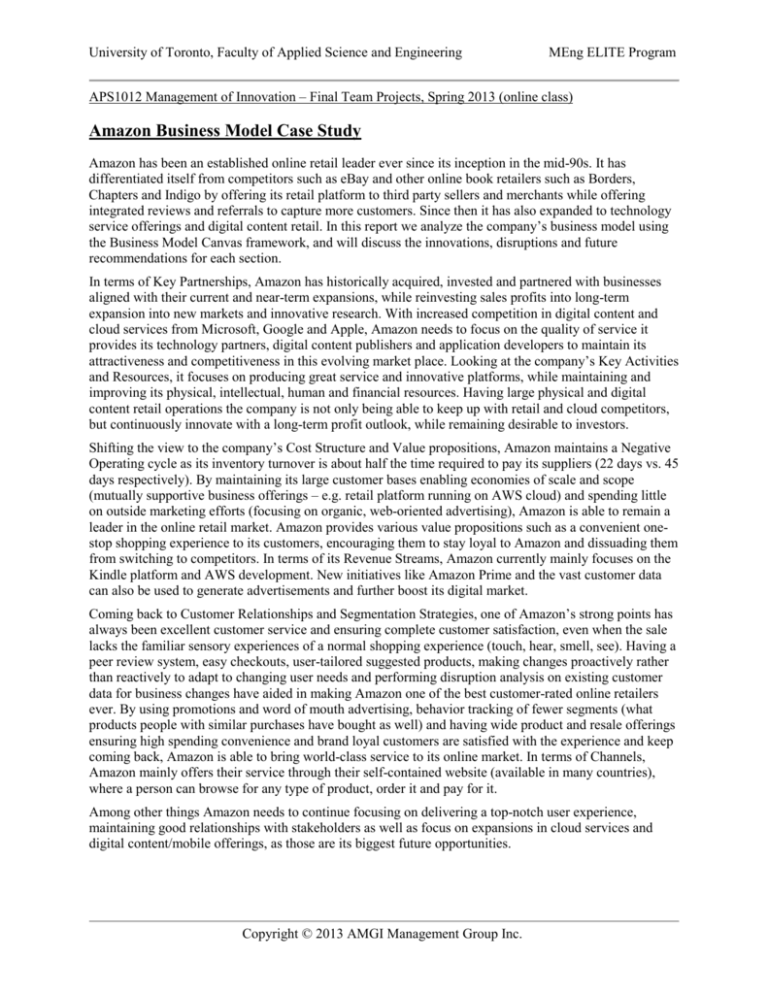Amazon Business Model Case Study - AMGI
advertisement

University of Toronto, Faculty of Applied Science and Engineering MEng ELITE Program APS1012 Management of Innovation – Final Team Projects, Spring 2013 (online class) Amazon Business Model Case Study Amazon has been an established online retail leader ever since its inception in the mid-90s. It has differentiated itself from competitors such as eBay and other online book retailers such as Borders, Chapters and Indigo by offering its retail platform to third party sellers and merchants while offering integrated reviews and referrals to capture more customers. Since then it has also expanded to technology service offerings and digital content retail. In this report we analyze the company’s business model using the Business Model Canvas framework, and will discuss the innovations, disruptions and future recommendations for each section. In terms of Key Partnerships, Amazon has historically acquired, invested and partnered with businesses aligned with their current and near-term expansions, while reinvesting sales profits into long-term expansion into new markets and innovative research. With increased competition in digital content and cloud services from Microsoft, Google and Apple, Amazon needs to focus on the quality of service it provides its technology partners, digital content publishers and application developers to maintain its attractiveness and competitiveness in this evolving market place. Looking at the company’s Key Activities and Resources, it focuses on producing great service and innovative platforms, while maintaining and improving its physical, intellectual, human and financial resources. Having large physical and digital content retail operations the company is not only being able to keep up with retail and cloud competitors, but continuously innovate with a long-term profit outlook, while remaining desirable to investors. Shifting the view to the company’s Cost Structure and Value propositions, Amazon maintains a Negative Operating cycle as its inventory turnover is about half the time required to pay its suppliers (22 days vs. 45 days respectively). By maintaining its large customer bases enabling economies of scale and scope (mutually supportive business offerings – e.g. retail platform running on AWS cloud) and spending little on outside marketing efforts (focusing on organic, web-oriented advertising), Amazon is able to remain a leader in the online retail market. Amazon provides various value propositions such as a convenient onestop shopping experience to its customers, encouraging them to stay loyal to Amazon and dissuading them from switching to competitors. In terms of its Revenue Streams, Amazon currently mainly focuses on the Kindle platform and AWS development. New initiatives like Amazon Prime and the vast customer data can also be used to generate advertisements and further boost its digital market. Coming back to Customer Relationships and Segmentation Strategies, one of Amazon’s strong points has always been excellent customer service and ensuring complete customer satisfaction, even when the sale lacks the familiar sensory experiences of a normal shopping experience (touch, hear, smell, see). Having a peer review system, easy checkouts, user-tailored suggested products, making changes proactively rather than reactively to adapt to changing user needs and performing disruption analysis on existing customer data for business changes have aided in making Amazon one of the best customer-rated online retailers ever. By using promotions and word of mouth advertising, behavior tracking of fewer segments (what products people with similar purchases have bought as well) and having wide product and resale offerings ensuring high spending convenience and brand loyal customers are satisfied with the experience and keep coming back, Amazon is able to bring world-class service to its online market. In terms of Channels, Amazon mainly offers their service through their self-contained website (available in many countries), where a person can browse for any type of product, order it and pay for it. Among other things Amazon needs to continue focusing on delivering a top-notch user experience, maintaining good relationships with stakeholders as well as focus on expansions in cloud services and digital content/mobile offerings, as those are its biggest future opportunities. Copyright © 2013 AMGI Management Group Inc.








